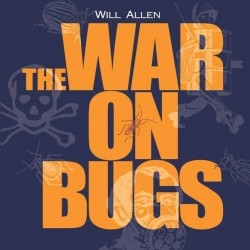The War on Bugs
“Many of us carry around a bucolic view of farming, ranching, and rural America. We think of farming as being toxic only after the introduction of DDT at the close of World War II. Such presumptions are wrong,” Will Allen writes. According to Allen, the government, the scientific community, and the press have been promoting the use of farm chemicals for 160 years.
Allen grew up on a farm in southern California, and served in the Marine Corps between Korea and Vietnam. After teaching anthropology at University of Illinois and U.C.-Santa Barbara, he was sentenced to a year in jail for civil rights and antiwar activism. (This information actually appears on the back cover of the book.) Since 1972 he’s been farming organically and full-time. For the last twenty years he has also been running a tour service for government, university, consumer, environment, press, and industry representatives. The tours include farms in California, Texas, and the mid-South where industrial agriculture is the most visible and devastating. According to Allen, one of the number one questions on the tours is, “Don’t the farmers know these chemicals are toxic?”
Of course, says Allen. Growing up, farmers were cautious to the point of paranoia about the storage and possible mishandling of farm chemicals. But there’s not much of a choice to use or not to use when banks require the use of chemicals to guarantee their loans.
Allen begins his story of synthetic fertilizers in depopulated post-Great Plague Europe, when common lands were appropriated by landowners for commercial farming and grazing. These were the first factory farms, and the practice continued in colonial America. There, large land tracts were held in trust by kings or investment groups that wanted a return. Although innovators like Jethro Tull warned about soil depletion in large-scale and intensive farming, landowners preferred to abandon a field rather than till it: there was always more land to be had.
The advent of commercial printing was the next nail in the coffin of sustainable farming, for advertising corrupts absolutely. Ben Franklin’s character takes a direct blow as he accepted ad dollars “no matter how odious its nature [like runaway slaves] or questionable its value.”
The discovery in Peru of guano at the beginning of the nineteenth century was the final beginning of the end of natural fertilizers, and in many ways was the foundation of modern chemistry. Guano harvesters and distributors knew that the natural product was limited, and chemists scurried to replace it with a synthetic substitute. Scientific experts contributed to the demise of the natural by touting the inferiority of local resources, like farmyard manure. The truly remarkable qualities of guano however, created an illusion of truthfulness in advertising. If Peruvian guano actually worked, why wouldn’t “Ichaboe,” “Pelican,” or “Fish” work as well? The age of snake oil for farmers was born.
The invention of pesticides follows from entirely different human need: medicine and public health. Allen weaves a fascinating picture of the connections between medicine, rat control, chemistry, and labor practices to arrive at the door of DDT, Roundup, and genetically engineered staple crops. While the “heroic” practice of medicine under Marcus Aurelius—basically triage, brutal and often fatal with its use of purging with toxic substances—was the beginning of chemical exploration, interestingly it was the Great Plague, again, and the use arsenic and heavy metals to poison rats, that pinpoints the beginning of the trajectory.
When the book moves into the war on bugs, the two-color, oversized images and text become ominous. “Paris Green” was an arsenic paint pigment used to kill the Colorado Potato Beetle (and this reviewer is reminded of the “Fire Retardant Green” paint used on her own childhood farm), and while the supersized images of old and new ads are mostly orange, perhaps it’s that color’s position opposite green on the color wheel that evokes a sickening feeling towards the final chapters.
“My goal is to provoke readers with some often overlooked historical perspectives about food and farming,” writes Allen in his introduction, “and to suggest what they can do to ensure that food is produced safely on land that is properly cared for, so that our children and grandchildren will be able to enjoy its bounty and continue to make it productive.” How could we not wish him well.
Disclosure: This article is not an endorsement, but a review. The publisher of this book provided free copies of the book to have their book reviewed by a professional reviewer. No fee was paid by the publisher for this review. Foreword Reviews only recommends books that we love. Foreword Magazine, Inc. is disclosing this in accordance with the Federal Trade Commission’s 16 CFR, Part 255.

